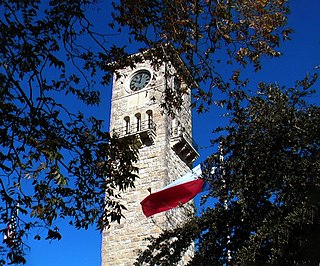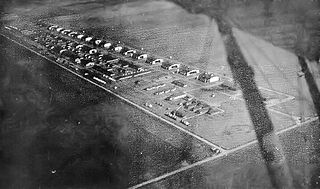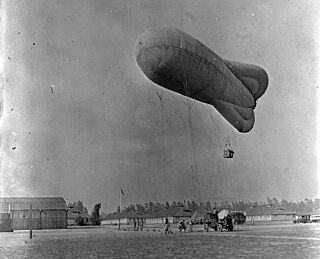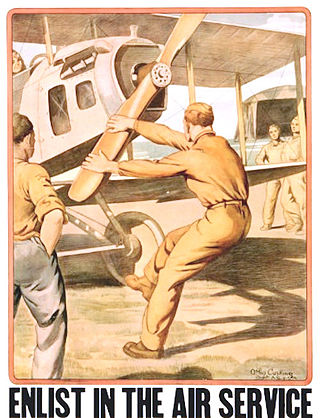
Fort Sam Houston is a U.S. Army post in San Antonio, Texas. Known colloquially as "Fort Sam," it is named for the U.S. Senator from Texas, U.S. Representative from Tennessee, Tennessee and Texas governor, and first president of the Republic of Texas, Sam Houston.

Barron Field is a former World War I military airfield, located 1.0 mile (1.6 km) West-southwest of Everman, Texas. It operated as a training field for the Air Service, United States Army between 1917 until 1921. It was one of thirty-two Air Service training camps established after the United States entry into World War I in April 1917.

Fort Sill is a United States Army post north of Lawton, Oklahoma, about 85 miles (137 km) southwest of Oklahoma City. It covers almost 94,000 acres (38,000 ha).

Kelly Field is a Joint-Use facility located in San Antonio, Texas. It was originally named after George E. M. Kelly, the first member of the U.S. military killed in the crash of an airplane he was piloting.

Brooke Army Medical Center (BAMC) is the United States Army's premier medical institution. Located on Fort Sam Houston, BAMC, is a 425-bed Academic Medical Center, and is the Department of Defense's largest facility and only Level 1 Trauma Center. BAMC is also home to the Center for the Intrepid, an outpatient rehabilitation facility. The center is composed of ten separate organizations, including community medical clinics, centered around the Army's largest in-patient hospital. BAMC is staffed by more than 8,000 Soldiers, Airmen, Sailors, Civilians, and Contractors providing care to wounded Service Members and the San Antonio Community at-large.

Fort Wolters was a United States military installation four miles northeast of Mineral Wells, Texas.
The Forts of Texas include a number of historical and operational military installations. For over 200 years, various groups fought over access to or control over the region that is now Texas. Possession of the region was claimed and disputed by the European powers of Spain and France, and the continental countries of Mexico, the United States, the Republic of Texas, and the Confederate States of America. Ownership of specific lands was claimed and disputed by different ethnic groups, including numerous Native American tribes, Mexican residents, Anglo- and African-American settlers, and European immigrants. Access to and control of resources were claimed and disputed by various economic groups, including indigenous hunter/gatherers, farmers, herders, ranchers, colonists, settlers, buffalo hunters, traders, bandits, smugglers, pirates, and revolutionaries. Over the centuries, claims and disputes were enforced by Native American warriors, Spanish conquistadors, French cavaliers, Texas Rangers, local militias, and uniformed regular army regiments of Spain, Mexico, Texas, the United States, and the Confederacy.

Fort Omaha, originally known as Sherman Barracks and then Omaha Barracks, is an Indian War-era United States Army supply installation. Located at 5730 North 30th Street, with the entrance at North 30th and Fort Streets in modern-day North Omaha, Nebraska, the facility is primarily occupied by the Metropolitan Community College. A Navy Operational Support Center and Marine Corps Reserve unit, along with an Army Reserve unit occupy the periphery of the 82.5 acres (33.4 ha) fort. The government deeded all but four parcels of the land to the Metropolitan Community College in 1974.

Lawson Army Airfield is a military airport located at Fort Moore in Chattahoochee County, Georgia, south of the city of Columbus, Georgia. It is Fort Moore's primary force projection platform.

Camp Bullis Military Training Reservation is a U.S. Army training camp comprising 27,990 acres (113.3 km2) in Bexar County, Texas, United States, just northwest of San Antonio. Camp Bullis provides base operations support and training support to Joint Base San Antonio. The camp is named for Brigadier General John L. Bullis.

Carlstrom Field is a former military airfield, located 6.4 miles (10.3 km) southeast of Arcadia, Florida. The airfield was one of thirty-two Air Service training camps established in 1917 after the United States entry into World War I.

The Medical Education and Training Campus (METC) is a United States Department of Defense (DoD) integrated campus under a single university-style administration, with nearly 50 programs of study available to U.S. military enlisted students and a small number of foreign military students. METC is located at Joint Base San Antonio on Fort Sam Houston, Texas with a field training site located at Camp Bullis.

Hicks Field is a former World War I military airfield, located 5.6 miles (9.0 km) North-northwest of Saginaw, Texas. It operated as a training field for the Air Service, United States Army between 1917 until 1920. It was one of thirty-two Air Service training camps established after the United States entry into World War I in April 1917.

Joint Base San Antonio (JBSA) is a United States military facility located in San Antonio, Texas, US. The facility is under the jurisdiction of the United States Air Force 502d Air Base Wing, Air Education and Training Command (AETC). The wing's three Mission Support Groups perform the installation support mission at the three bases that form JBSA.

Henry Post Army Airfield is a military use airport located at Fort Sill in Comanche County, Oklahoma, United States. This military airport is owned by United States Army. Established as Post Field in 1917, it was one of thirty-two Air Service training camps established after the United States entry into World War I in April 1917.

United States Army balloon squadrons and companies organized under the Aviation Section, U.S. Signal Corps and served overseas with the United States Army Air Service before and during World War I. There were also French, British, and German balloon corps.

With the purchase of its first airplane, built and successfully flown by Orville and Wilbur Wright, in 1909 the United States Army began the training of flight personnel. This article describes the training provided in those early years, though World War I, and the immediate years after the war until the establishment of the United States Army Air Corps Flight Training Center in San Antonio, Texas during 1926.

Call Field is a former World War I military airfield, located 4.6 miles (7.4 km) southwest of Wichita Falls, Texas. It operated as a training field for the United States Army Air Service between 1917 until 1919. The airfield was one of thirty-two Air Service training camps established in 1918 after the United States entry into World War I.

Ross Field is a former World War I military airfield, located 0.8 miles (1.3 km) south-southwest of Arcadia, California. It was one of thirty-two Air Service, United States Army training camps established after the United States entry into World War I in April 1917. It operated as a training field between 1918 until 1919.



















